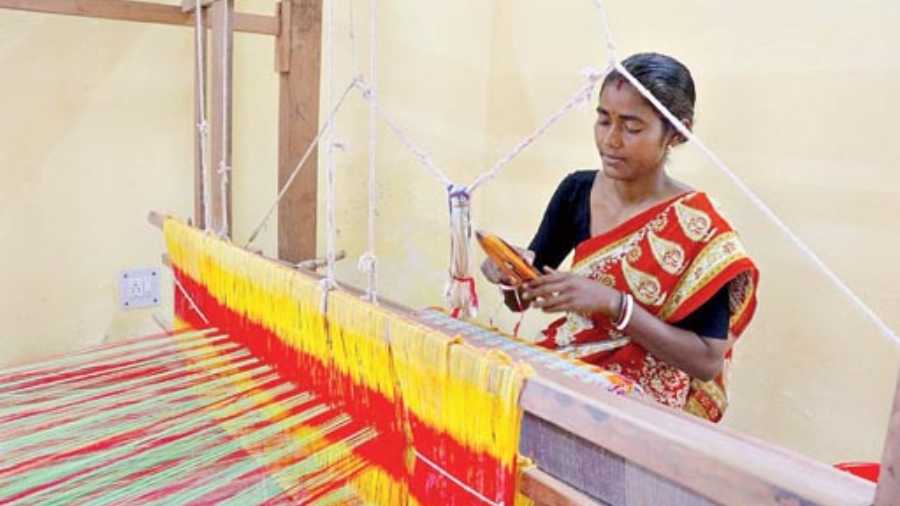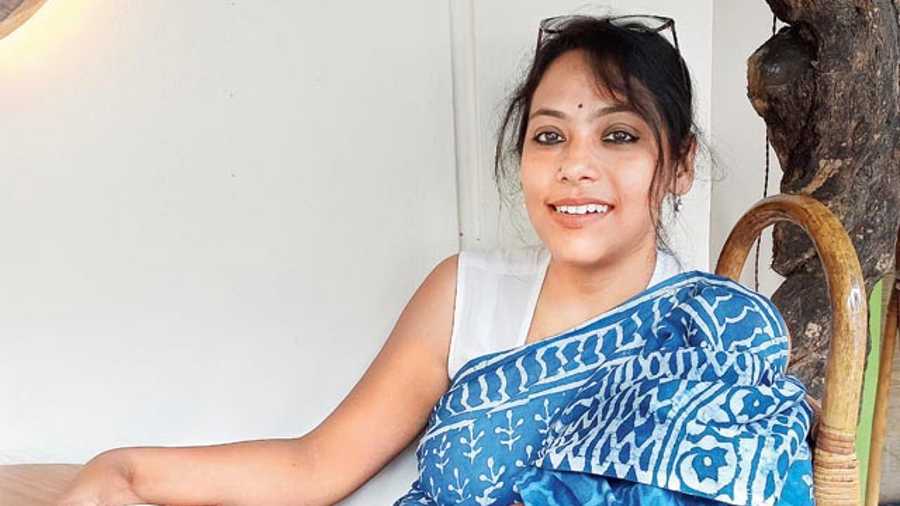The first time we shot in Moram in 2018, we were blown away by the lush beauty of the design centre in Santiniketan, which also happens to be an eco-resort. So, this time when Moram chiefs — the inimitable husband-wife duo Sonali Chakraborty and Gopal Poddar — extended another invitation, we jumped at the opportunity of another quick getaway. The founder-members of AIM (Art Illuminates Mankind), “a social welfare organisation” formed more than 14 years back, had just put together their first collection of saris called ‘Maku’. The saris were simple and stunning, open to versatile styling. We tried classic drapes on the cotton and khadi beauties, but with a twist in accessories or blouses. Sonali later chatted with t2 on ‘Maku’ and more...
Congratulations on your first sari collection. They look lovely. Tell us about the designs…

This is our first sari collection ‘Maku’, which we have dedicated to our first-generation tribal weaver Maku Hansda. She is the team leader of our weaving section. We have a vast diversity of saris, which are mostly embellished with Bengal checks, borders and the other traditional Bengal designs like the very common matha paar. We wanted to fuse Bengali traditional designs with genuine simplicity and in a way to revive and preserve our traditional heritage. Our collection of saris is simple and suffused with elegance.
Tell us about the hands weaving them.
Well, that is a great question. We have numerous hands and numerous faces. All of them have myriad stories which get reflected in the art they create. We are nothing but a lifeless brand had it not been for these women who infused life in it. These women come from different backgrounds. Most of them are from the nearby villages.
The women have joined our trained tribal artisans and are now our strength. They all come to the Centre (Common Facility Centre), which is established by SC ST & OBC Development and Finance Corporation of West Bengal. At a time when the power loom industry is taking over handlooms, the women from the villages decided to help us in preserving the handloom sector and we are always grateful to them.
How long has this been in the making?
Well, it has been around two months since we transformed our vision into reality.
Tell us more about the new centre where their saris are being woven.
CFC (Common Facility Centre) is the new centre for the artisans of Debanandapur cluster and the beneficiaries are grateful to the Backward Classes Welfare department for taking up this initiative. This CFC started its functioning in 2020 and touch wood, it is running successfully. It feels like a blessing to be a part of something so massive. Our only aim is to bring out the stories of the unheard and the marginalised sections of our society. All the training and workshops are being implemented by us to uplift the artisans from the backward class and boost their growth.
What are your plans for the centre?
Honestly, we feel that in the long run, the government must have some massive plans for the future. We are progressing each day towards our goal of implementing various training programmes of several art forms from all across the country that are on the verge of getting extinct. We have been conducting various design workshops here. We are also conducting multiple workshops on folk performances with artisans from across the country like batik and several other art forms. We are dreaming of developing a craft and design training institute for the next generation of backward class artisans that will bolster both the handloom and handicraft sector as well as the traditional heritage.
Seeing so many women being empowered is so heartening. What have the girls been telling you?
Isn’t it? It just feels that, yes, we have at least done some good in life. When we see the smiling faces running the wheels and spinning their stories, it is so refreshing! The smiling faces have many stories. Some of them are happy and some are filled with sorrow but when these smiling stories form an assemblage in our centre, there are only smiling faces. A bunch of vibrant girls who are supporting each other to sustain in this patriarchal regime. We always try to encourage them and honestly I think we have done what was necessary! We have introduced them to a dream, an ambition to free themselves from any restrictions. So many girls take these training workshops and then they themselves become trainers. It just feels like a ray of sunshine when we see them giggling, talking with their eyes while creating the pieces of magic.
They are fast learners, right?
We have pretty diverse kinds of artisans. Like there are a few traditional artisans who are well familiar with this craft for years now. Also simultaneously some novices are new to this craft form. But on a positive note, all of them are really quick learners. Interestingly, women are faster learners than men.
What new styles are they weaving?
Well, to start with, the artisans of Lavpur, are accustomed to making khesh. Very interestingly, after they came to our design centre, they had to work on khadi, which is almost like a paradigm shift for them. To be honest, they weren’t that much comfortable in the beginning but not only did they learn it but also mastered the intricacies of the craft over time. They have just created magic out of their vision.
What are your personal favourites?
I certainly have a weakness towards the indigo-and-white check. I will recommend simple designs with traditional touches, which enhances the elegance of the costume.
What else are you planning to teach the girls?
We have numerous plans! We are tirelessly working to reach our vision. We have already started expanding our area of training to a diverse range of crafts like khadi, spinning, ceramic, pottery and that of woven khadi silk. We also plan to organise a few more workshops on traditional art forms. You will be amazed to know that we have already distributed box charkha among the tribal women of the villages so they can weave their saris. We wish to take forward our Tagore and Gandhian concept of sustainability and women empowerment, the very ethos we religiously believe in.
More about the collection

1(L-R) Runa Laha, Ushoshi Sengupta and Diti Saha looked straight out of a painting in shades of white. And the eyes did all the talking. Diti and Ushoshi rocked the brown smokey kohl eyes with a heavy coating of mascara and Runa’s dark smokey eyes complemented her messy bun. Great for a daytime do.
2Checks and blue! So smart. We paired the saris with Western tops and a modern choli for a contemporary feel. The neat hair and just the right amount of accessories added to the fusion vibe.
3The beautiful eyes, the red bindi and the flower added to the power and subtle elegance that defined this frame and aptly complemented Ushoshi’s personality.
4Diti was such a beauty in this classic red-and-white sari. The defined eyes and the red bindi enhanced the loveliness.
Pictures: Pabitra Das
Models: Diti Saha, Ushoshi Sengupta, Runa Laha
Stylist: Ankita Banerjee;
Styling assistant: Ravi Chaudhary
Hair and make-up: Abhijit Paul;
Hair and make-up assistant: Sananda Mondal Laha
Jewellery: Karishmaz
Location: Moram, Santiniketan
